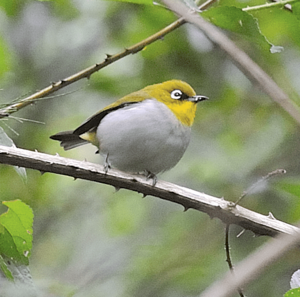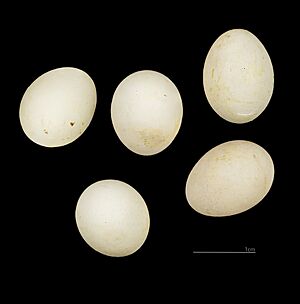Malagasy white-eye facts for kids
Quick facts for kids Malagasy white-eye |
|
|---|---|
 |
|
| Conservation status | |
| Scientific classification | |
| Genus: |
Zosterops
|
| Species: |
maderaspatanus
|
The Malagasy white-eye (Zosterops maderaspatanus) is a small, lively bird that belongs to the white-eye family, Zosteropidae. You can find these birds in Madagascar and the Seychelles. They love living in different kinds of forests, like dry forests, moist lowland forests, mangrove forests, and moist mountain forests.
Contents
About Its Name
The Malagasy white-eye got its scientific name from Carl Linnaeus in 1766. He first called it Motacilla maderaspatana. Even though the bird lives in Madagascar, the name maderaspatana comes from "Madras" (now Chennai) in India. This might seem a bit confusing!
Today, this bird is placed in the genus Zosterops. This group of birds was named by naturalists Nicholas Vigors and Thomas Horsfield in 1827.
Different Types of Malagasy White-eyes
There are four known types, or subspecies, of the Malagasy white-eye:
- Z. m. aldabrensis (found on Aldabra island in the southwest Seychelles)
- Z. m. maderaspatanus (found in Madagascar and the Glorioso Islands)
- Z. m. voeltzkowi (found on Europa Island)
- Z. m. menaiensis (found on Cosmoledo Atoll and Astove Island)
What It Looks Like
This white-eye is a small bird, growing to about 10 centimetres (4 inches) long. Its upper body, wings, and tail are a dark olive green color. The throat is yellow, and its chest and belly are pale grey.
It has a special white ring around its reddish-brown eye, but this ring isn't complete; it has a small gap at the front. The top part of its beak is black, and the bottom part is grey. Its legs and feet are greyish-blue.
Where It Lives and Its Home
The Malagasy white-eye lives in Madagascar and the Seychelles. You can often spot small groups of these birds in woodlands. They fly around among the branches, constantly calling to each other with a soft "pee-u" sound.
Its Daily Life and Habits
This bird is very lively and quick! It flies strongly but in short, jerky bursts. During the day, it looks for food in open areas. At night, it moves deeper into the forest to sleep.
The Malagasy white-eye loves to bathe! It uses pools of water or even water collected in hollows of trees. Sometimes, two birds will preen each other, almost leaning on one another as they clean around each other's heads and faces.
What It Eats
This bird mainly eats small invertebrates (like insects) and fruits. It also enjoys nectar, pollen, flower buds, and other plant parts. It finds insects by looking closely at twigs and branches, sometimes even hanging upside-down on a tree trunk! It can also catch insects in the air while flying. Sometimes, it hovers briefly to grab food or probes into flowers and lichens, which can leave it dusted with pollen.
Reproduction and Life Cycle
Malagasy white-eyes usually breed during the summer months in the Southern Hemisphere. They build a cup-shaped nest, often hanging it from a fork in a branch or hidden in the middle of a bush. The nest is carefully made from grass stems, flower heads, fine roots, slender fibers, hairs, and moss. The female usually lays two to three eggs.
Its Conservation Status
The Malagasy white-eye is found over a very large area and is considered a common bird. There are no major threats to this species right now. Because of this, the International Union for Conservation of Nature says its conservation status is "least concern". This means it's not currently at risk of disappearing.



